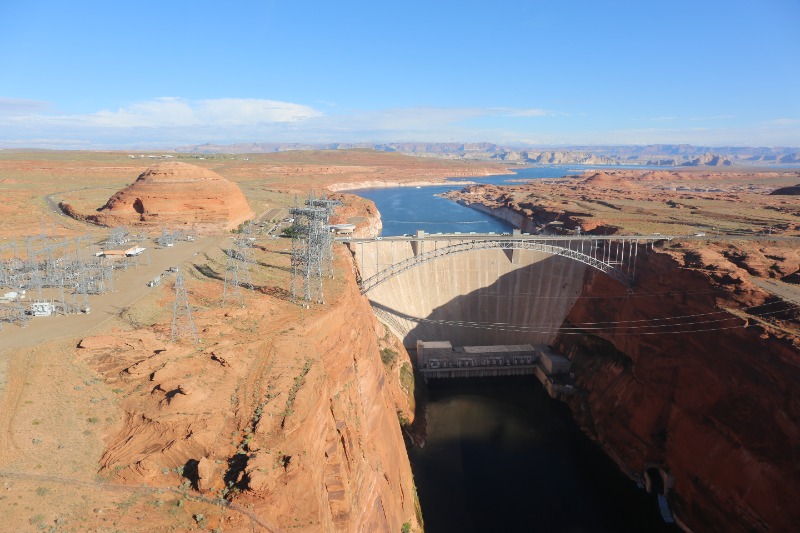Electricity produced at Lake Powell’s Glen Canyon Dam, which serves some 50 Colorado utilities, and dozens of others in the Colorado River Basin, has been cut in half by the 20-year drought, with power levels over the next two years projected to be 47% lower than normal, according to the U.S. Bureau of Reclamation.
“We’re going to be generating less than we have in quite some time. It will be among the lowest years of generation ever,” said Nick Williams, power manager for the U.S. Bureau of Reclamation’s Upper Colorado River Region in an interview last week.
The grim forecast comes as water officials race to bolster Lake Powell’s water levels. On April 8, Reclamation announced it would likely keep more water in Lake Powell, reducing releases from the planned 7.5 million acre-feet to 7 million acre-feet, a move that could trigger emergency water cutbacks in Arizona, California and Nevada.
At the same time, electric utilities across the West are looking for other green power options and hoping that hydropower production won’t stop altogether. According to Reclamation, there is a 27% chance that Powell will still stop generating electricity completely over the next four years.
“If Glen Canyon Dam ceases to operate, we are going to have to replace that power somewhere else and it will have a bigger carbon footprint,” said Bryan Hannegan, CEO of Holy Cross Energy, which buys Lake Powell’s hydropower to serve customers in Western Colorado.
The picture was much different 59 years ago, when the giant storage reservoir on the Colorado River was filling, its electricity helping power the West and the revenue from its power sales helping fund endangered fish protection programs across the Colorado River Basin.
Back then, Hannegan said, “We made an assumption that our WAPA (Western Area Power Administration) allocation would be firm, reliable and always there. Now, though, we know that it’s not firm, it’s not reliable, and it’s coming at a much higher cost.”
Late last fall WAPA, which operates the electric grid and distributes the power to utilities, raised rates 30% to cover reductions in power revenue. Few expected to ever see this drop in hydropower production, let alone consider what to do if Glen Canyon were to cease electricity production entirely.
“The forecast is changing daily and there are still a lot of variables,” said Lisa Meiman, a spokeswoman for WAPA. ”But it is concerning. This is the big warning bell.”
The drop in the power forecast comes as Upper Colorado River Basin states of Colorado, New Mexico, Utah and Wyoming prepare to finalize a new drought operations plan for the giant river system. The draft plan is expected to be released next week, according to Becki Bryant, a spokeswoman for Reclamation’s Upper Colorado River Region.
The critical issue is how to maintain the lake at 3,525, which marks an elevation that is the top of the liquid buffer zone designed to protect the lake’s mighty electricity turbines.
Last July, to protect the 3,525 buffer zone, Reclamation ordered emergency water releases from three reservoirs in the Upper Colorado River Basin. Utah’s Flaming Gorge, Colorado’s Blue Mesa and New Mexico’s Navajo.
Despite those releases, Powell dropped below 3,525 last month, hitting 3,523, another historic drought landmark.
Though the 2022 forecast isn’t expected to be finalized until later this month, water officials expect that more water will have to be released from Upper Basin storage reservoirs this summer because inflows into the lake from the drought-stressed Colorado River are expected to be well below average again, in the 60% to 80% range.
Becky Mitchell is director of the Colorado Water Conservation Board, the state’s lead water planning agency. She also sits on the Upper Colorado River Commission. Mitchell declined to discuss the pending drought operations plan. But in a statement, she said, “The Upper Basin States are working collaboratively with the Bureau of Reclamation to draft a 2022 Drought Response Operations Plan outlining potential releases from Upper Basin reservoirs in an effort to protect critical elevations at Lake Powell. The Upper Basin reservoirs have already provided 161,000 acre-feet of water pursuant to the ’imminent need‘ provision of the Drought Response Operations Agreement, including 36,000 acre-feet from Blue Mesa Reservoir in Colorado. Water availability, appropriate timing of releases, and impacts on other resources are all being considered as the 2022 Plan is being drafted.”
Across the region, water utilities are in high-alert mode, preparing for another dry year on the Colorado River and holding hope that the Upper Basin reservoirs can be protected as long as possible from large-scale drought releases.
“The forecast isn’t great,” said Kyle Whitaker, Colorado River Manager for the Northern Colorado Water Conservancy District, one of the largest diverters of water in the headwaters region of the river.
“It’s better than last year, but we’ll just have to see what the next two to four weeks holds for precipitation.”
At the same time, power producers are gearing up to craft a fallback plan for extending hydropower production at Glen Canyon Dam if water levels continue to fall.
“We have to take a strong look at what we will do in the unlikely event that Lake Powell stops producing hydropower,” said WAPA’s Meiman. “It’s not a hypothetical situation anymore.”
Correction: This article has been corrected to indicate that Lake Powell began filling 59 years ago, not 60 years, as the original article stated.
Jerd Smith is editor of Fresh Water News. She can be reached at 720-398-6474, via email at jerd@wateredco.org or @jerd_smith.
Fresh Water News is an independent, nonpartisan news initiative of Water Education Colorado. WEco is funded by multiple donors. Our editorial policy and donor list can be viewed at wateredco.org


 Print
Print